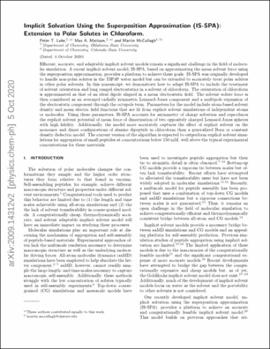| dc.contributor.author | Lake, Peter T | |
| dc.contributor.author | Mattson, Max A | |
| dc.contributor.author | Mccullagh, Martin | |
| dc.date.accessioned | 2022-10-18T21:41:25Z | |
| dc.date.available | 2022-10-18T21:41:25Z | |
| dc.date.issued | 2020-09-29 | |
| dc.identifier.citation | Lake, P.T., Mattson, M.A., McCullagh, M. (2020). Implicit Solvation Using the Superposition Approximation (IS-SPA): Extension to Polar Solutes in Chloroform. https://doi.org/10.48550/arxiv.2009.14312 | |
| dc.identifier.uri | https://hdl.handle.net/11244/336546 | |
| dc.description.abstract | Efficient, accurate, and adaptable implicit solvent models remain a significant challenge in the field of molecular simulation. A recent implicit solvent model, IS-SPA, based on approximating the mean solvent force using the superposition approximation, provides a platform to achieve these goals. IS-SPA was originally developed to handle non-polar solutes in the TIP3P water model but can be extended to accurately treat polar solutes in other polar solvents. In this manuscript, we demonstrate how to adapt IS-SPA to include the treatment of solvent orientation and long ranged electrostatics in a solvent of chloroform. The orientation of chloroform is approximated as that of an ideal dipole aligned in a mean electrostatic field. The solvent–solute force is then considered as an averaged radially symmetric Lennard-Jones component and a multipole expansion of the electrostatic component through the octupole term. Parameters for the model include atom-based solvent density and mean electric field functions that are fit from explicit solvent simulations of independent atoms or molecules. Using these parameters, IS-SPA accounts for asymmetry of charge solvation and reproduces the explicit solvent potential of mean force of dimerization of two oppositely charged Lennard-Jones spheres with high fidelity. Additionally, the model more accurately captures the effect of explicit solvent on the monomer and dimer configurations of alanine dipeptide in chloroform than a generalized Born or constant density dielectric model. The current version of the algorithm is expected to outperform explicit solvent simulations for aggregation of small peptides at concentrations below 150 mM, well above the typical experimental concentrations for these materials. | |
| dc.format | application/pdf | |
| dc.relation.uri | http://arxiv.org/abs/2009.14312v2 | |
| dc.rights | This material has been previously published. In the Oklahoma State University Library's institutional repository this version is made available through the open access principles and the terms of agreement/consent between the author(s) and the publisher. The permission policy on the use, reproduction or distribution of the material falls under fair use for educational, scholarship, and research purposes. Contact Digital Resources and Discovery Services at lib-dls@okstate.edu or 405-744-9161 for further information. | |
| dc.title | Implicit solvation using the superposition approximation (IS-SPA): extension to polar solutes in chloroform | |
| dc.date.updated | 2022-09-20T17:36:14Z | |
| dc.identifier.doi | 10.48550/arxiv.2009.14312 | |
| dc.description.department | Chemistry | |
| dc.type.genre | Preprint | |
| dc.type.material | Text | |
| dc.subject.keywords | physics.chem-ph | |
| dc.subject.keywords | cond-mat.stat-mech | |
| dc.identifier.author | ORCID: 0000-0002-8603-4388 (McCullagh, Martin) | |
| dc.identifier.author | ScopusID: 24829766700 (McCullagh, Martin) | |
